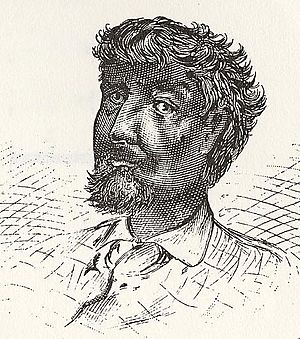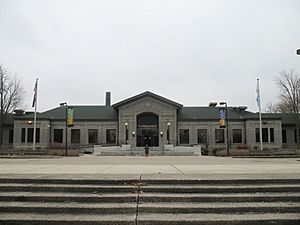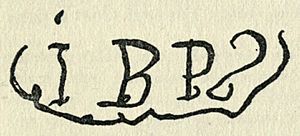Jean Baptiste Point du Sable facts for kids
Quick facts for kids
Jean Baptiste Point du Sable
|
|
|---|---|

There are no known portraits of Jean Baptiste Point du Sable made during his lifetime. This depiction is taken from A.T. Andreas' book History of Chicago (1884).
|
|
| Born | 1740s? |
| Died | August 28, 1818 St. Charles, Missouri Territory, U.S.
|
| Occupation | Trader |
| Known for | "Founder of Chicago" |
| Signature | |
Jean Baptiste Point du Sable (born before 1750 – died August 28, 1818) is known as the first person to live permanently in what is now Chicago, Illinois. Because of this, he is called the "Founder of Chicago." Many places are named after him, like a school, a museum, a harbor, a park, and a bridge. The spot where he settled near the Chicago River in the 1780s is now a special place called a National Historic Landmark.
Contents
Biography
Point du Sable was a man of African descent. People believe he was from Haiti, which was a French colony called Saint-Domingue back then. We don't know much about his early life before the 1770s.
During his life, the lands where he lived and traded changed hands many times. These areas were around the Great Lakes and in the Illinois Country. They were controlled by France, Britain, Spain, and later the new United States.
Point du Sable was described as handsome and well-educated. He married a Native American woman named Kitiwaha. They had two children together.
In 1779, during the American Revolutionary War, he was living in what is now Michigan City, Indiana. The British military arrested him because they thought he supported the Americans. In the early 1780s, he worked for the British in a place called Michilimackinac.
The first written record of Point du Sable living at the Chicago River was in a trader's journal from 1790. He had settled there some time before this. He built a large and successful trading post in the area that would become Chicago.
In 1800, he sold his property in Chicago. He then moved to St. Charles, Missouri, where he ran a ferry across the Missouri River. For a long time, people didn't fully recognize Point du Sable's important role in starting the Chicago settlement. He died on August 18, 1818, in St. Charles, Missouri.
Honoring Jean Baptiste Point du Sable
Why He's Called the Founder of Chicago
French explorers came to the middle of North America in the 1600s. Louis Jolliet and Jacques Marquette explored the Mississippi Valley in 1673. They were likely the first Europeans to travel through the Chicago area. They crossed the Chicago Portage and went along the Chicago River.
Over the years, more people visited, and small trading posts were set up. But Point du Sable's settlement in the 1780s was the first one that stayed and grew. This settlement eventually became the big city of Chicago. That's why he is widely seen as Chicago's first permanent resident and is called the "Founder of Chicago."
Memorials and Recognition
By the 1850s, Chicago historians knew Point du Sable was the city's first non-native permanent resident. However, for a long time, the city didn't honor him as much as other early settlers. In the 1800s, people often forgot about Point du Sable. Instead, a Scots-Irish trader named John Kinzie, who bought Point du Sable's land, often got the credit for starting the settlement.
In 1913, a plaque was put up to remember the Kinzie home. Later, for the 1933–1934 Century of Progress International Exposition (a big fair), African-American groups worked hard to get Point du Sable honored. Many Chicagoans hadn't even heard of him then. The fair's organizers first focused on Fort Dearborn, built in 1803, as Chicago's beginning. But the campaign worked! A copy of Point du Sable's cabin was shown at the fair as part of Chicago's early history.
In 1965, a public space called Pioneer Court was built where Point du Sable's home once stood. This site was named a National Historic Landmark in 1976. This means it has "exceptional value to the nation." Pioneer Court is at 401 N. Michigan Avenue. In 2009, a large bronze statue (bust) of Point du Sable was placed there. It was made by sculptor Erik Blome.
In October 2010, the Michigan Avenue Bridge was renamed the DuSable Bridge to honor him. A smaller street had already been named De Saible Street. In 2021, Lake Shore Drive in Chicago was also renamed in his honor.

Several important places are named after Point du Sable. DuSable High School opened in Chicago in 1934. Today, this campus has other schools inside it. Margaret Taylor-Burroughs, a famous African-American artist, taught there. She and her husband started the DuSable Museum of African American History. It was renamed for Point du Sable in 1968.
DuSable Harbor is a boat harbor in downtown Chicago. DuSable Park is a 3.24-acre park in Chicago that is still being developed. There is also a park named after him in St. Charles, Missouri, where he lived later in life. The United States Postal Service also honored Point du Sable. They released a 22-cent postage stamp with his image on February 20, 1987.
Images for kids
-
Map of eastern North America in the late 1700s. Point du Sable lived near Lake Michigan and the Illinois Country (center left).
See also
 In Spanish: Jean Baptiste Point DuSable para niños
In Spanish: Jean Baptiste Point DuSable para niños




